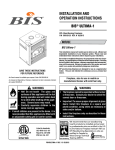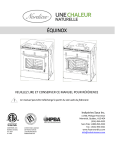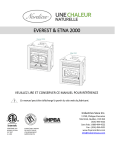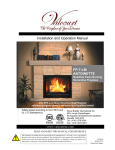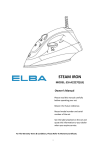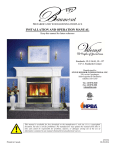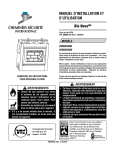Download Security Chimneys HE43-2 Instruction manual
Transcript
Manuel d’installation et d’utilisation Ces instructions ont pour but de vous permettre d’effectuer une installation simple et sécuritaire du foyer et de la cheminée. S.V.P. lisez attentivement les informations contenues dans ce manuel avant de débuter l’installation de votre foyer. Mise en garde: Toutes modifications au foyer ou à ses composantes peuvent entraîner des répercussions dangereuses, voire annuler l’homologation du foyer et sa garantie et dégager Cheminées Sécurité International Ltée de toutes responsabilités. Respectez les instructions d’installation présentées dans ce manuel. CONSERVEZ CES INSTRUCTIONS POUR RÉFÉRENCE FUTURE • • Chaud! Ne pas toucher! Les vitres et surfaces de cet appareil seront chaudes durant l’utilisation et le resteront après l’avoir éteint. Peut causer des brûlures sévères. • Surveiller les enfants qui se trouvent dans la même pièce que l’appareil. S’il y a de jeunes enfants dans la maison, il est recommandé d’utiliser un écran pare-feu devant cet appareil. ATTENTION: Le foyer ne peut fonctionner sans portes. Informez-vous auprès de votre détaillant pour connaître le modèle de portes approprié. Homologué selon les normes ULC-S610 & UL-127 Rapport # 3047213 2125 rue Monterey, Laval, Québec, Canada, H7L 3T6 Imprimé au Canada Rév 5 avril. 2007 PIBISTRAD 25 YEAR LIMITED WARRANTY • Security Chimneys International Ltd. warrants to the owner of a Security Fireplace that the wood burning fireplace will be free from defects in material and workmanship, under normal use and service, for a period of twenty-five (25) years from the date of purchase. A proof of purchased date is required for claims to be processed. This warranty is conditional to the proper use, operation and maintenance of the fireplace. This 25-year warranty is limited to the residential use of the product only. This warranty shall be void if the fireplace is not installed and operated in accordance with the installation instruction manual provided with the product and does not cover damage caused by misuse of the product. • Security Chimneys International Ltd warrants the gold, nickel, brushed nickel plating on its doors and facades against material and manufacturing defects for the lifetime of the fireplace. This lifetime warranty contains limitations which are detailed below. Door and façade adjustments, as described in the installation manual, MUST be done at installation time otherwise this warranty is void. WARRANTY LIMITATIONS: 1. During the first year of the limited warranty, Security Chimneys International Ltd. will provide replacement parts (as described in the document Details of the Limited 25 year Warranty) at no charge and will also pay for reasonable labour costs incurred for repair work. All repairs must be approved by an authorised company official before any work is done. Labour costs to be borne by Security Chimneys International Ltd. must not exceed the retail price of the parts replaced. 2. During the second through the fifth year of the limited warranty, Security Chimneys International Ltd. will provide replacement parts (as described in the document Details of the Limited 25 year Warranty) at no charge should they be found to be defective. Security Chimneys International Ltd. shall not be responsible for any labour costs. 2.1 During the second through the fifth year of the limited warranty, Security Chimneys International Ltd. will repair or replace at no charge, any plated door or façade that is found to be defective and will assume the necessary labour costs to replace this part. 3. During the sixth through the twenty-fifth year of the limited warranty, Security Chimneys International Ltd. will provide replacement parts (if available and as described in the document Details of the Limited 25 year Warranty) at 50% of the published List Price sheet. Security Chimneys International Ltd shall not be responsible for any labour costs. 3.1 After the sixth year of the limited warranty, Security Chimneys International Ltd. will repair or replace at no charge, any plated door or façade that is found to be defective and will not assume any labour costs to replace this part. 4. The following parts are not covered by any warranty: Brass accessories installed on the fireplace: trims, louvers, surround kits. This warranty may not be extended by our representatives in any manner whatsoever. The warrantor makes no warranties express or implied, written or oral, other than those specifically stated in this 25 year limited warranty. The duration of any implied warranty including that of merchantability or fitness for any particular purpose shall be limited to 25 years from the date of purchase. The remedy for damages as the result of any defect in this product that has been warranted herein is limited to the replacement of defective parts and does not include any incidental or consequential damages or expenses sustained in connection with the product, including damage to property. Security Chimneys International is not responsible for the inadequate performances of the fireplace caused by the environment such as trees, buildings, roofs, wind, hills, mountains near by, which may cause negative pressures inside the home or mechanical causes such furnaces, blowers or cloth dryers. The chimney is covered by a separate warranty. NOTE: Dated proof of purchase is required for recognition of this warranty. FOR UNITED STATES ONLY: Some states do not allow limitations on how long an implied warranty lasts, so the above limitations may not apply to you. Some states do not allow the exclusion or limitation of incidental or consequential damages, so the above limitation or exclusion may not apply to you. This warranty gives you specific legal rights and you may also have other rights that vary from state to state. Details Of The 25 Year Limited Fireplace Warranty Year 1: (see on page for exclusions and conditions) Years 6 to 25: Parts at 50% of published list price (see on page for exclusions and conditions) Air control assembly Plate, lever Air control assembly Plate, lever Blower assembly Blowers, wires, thermo disc Air register assembly Plate, lever Ceramic glass Glass (thermal breakage) Door assembly Door, latch assembly, hinges, glass retainer, gaskets Catalytic combustor Combustor (thermal degradation and disintegration), retainer Facade assembly Facade, hardware Parts and labour (no charge) Air register assembly Plate, lever Door assembly Door, latch assembly, hinges, glass retainer, gaskets Facade assembly Facade, hardware Fire box assembly Fire box, tube supports, tubes, deflectors Refractory Refractory (thermal breakage) Fire box assembly Fire box, tube supports, tubes, deflectors Exclusions: Brass accessories installed on the fireplace: trims, louvers, surround kits. Conditions: 1. Paint Doors, louvers, fireplace facade Accessories Log retainers, fire screen Years 2 to 5: Parts (no charge) (see on page for exclusions and conditions) Air control assembly Plate, lever 2. 3. 4. Catalytic combustor Combustor (thermal degradation and disintegration), retainer Air register assembly Plate, lever 5. Door assembly Door, latch assembly, hinges, glass retainer, gaskets 6. Facade assembly Facade, hardware Fire box assembly Fire box, tube supports, tubes, deflectors The 25-year warranty begins from the date of purchase of the fireplace and is valid as long as this fireplace remains installed in its original home. The fireplace must be installed, operated and maintained in accordance with the instructions described in the installation manual provided with it. Any alteration, modification, accident, neglect or abuse of the product will void this guarantee. A slight discoloration of painted parts, expansion, contraction or movement of certain parts, which cause light clicking noises, is normal and is not a manufacturing defect. Over firing of the fireplace (operation which causes metal parts to become red) can cause significant damage, create a fire hazard and voids the warranty. Security Chimneys International is not responsible for the inadequate performances of the fireplace caused by the environment such as trees, buildings, roofs, wind, hills, mountains near by, which may cause negative pressures inside the home or mechanical causes such furnaces, blowers or cloth dryers. This warranty does not cover normal wear and tear like the discolouration or peeling of painted parts, worn or cut gaskets, chipped or cracked refractory. Although your BIS fireplace is very efficient, it should not, in any case, replace the main heating system of the home in which it is installed. This fireplace is designed to supplement heat and comfort to the existing main heating system. TABLE OF CONTENTS Page 1. SAFETY RULES ...................................................................................................... 1 2. CERTIFICATION LABEL ..................................................................................... 2 3. THE FIREPLACE .................................................................................................... 3 4. 3.1 INTRODUCTION ......................................................................................................................... 3 3.1.1 Parts Required 3.1.2 Additional Equipment (optional) 3.2 OPERATING THE BIS TRADITION CE ................................................................................. 4 3.2.1 Fuel 3.2.2 First Fires 3.2.3 Building a Fire 3.2.4 Primary Air and Air Boost Controls 3.2.5 Accelerated Combustion 3.2.6 Medium Combustion 3.2.7 Slow Combustion 3.2.8 Refuelling For Best Performance 3.2.9 Smoking – Causes And Troubleshooting 3.3 MAINTAINING YOUR BIS TRADITION CE .......................................................................... 8 3.3.1 Creosote 3.3.2 Chimney Maintenance 3.3.3 Top Baffle Removal Prior to Cleaning The Chimney 3.3.4 Dealing With a Chimney Fire 3.3.5 Finish Door Casing Care 3.3.6 Ashes 3.3.7 Refractory Installation 3.3.8 Door Installation 3.3.9 Door Adjustment 3.3.10 Glass Care – Replacement 3.3.11 Glass Care – Cleaning 3.3.12 Gasket Replacement 3.4 FIREPLACE INSTALLATION .................................................................................................. 12 3.4.1 Locating The BIS TRADITION CE 3.4.2 Hearth Extension Requirements 3.4.3 Framing, Facing And Mantel 3.5 HOT AIR DUCTING INSTALLATION .................................................................................... 18 3.5.1 Gravity Kit 3.5.2 Central Forced Air Kit 3.6 OUTSIDE AIR KIT ...................................................................................................................... 22 3.6.1 Outside Air Kit Installation THE CHIMNEY ......................................................................................................... 23 4.1 CHIMNEY INSTALLATION NOTES ...................................................................................... 23 4.2 CHIMNEY INSTALLATION INSTRUCTIONS ...................................................................... 24 4.3 4.4 OFFSET CHIMNEY INSTALLATION .................................................................................... 27 ANGLED WALL RADIATION SHIELD .................................................................................. 30 4.5 CHIMNEY SUPPORTS INSTALLATION ............................................................................... 31 4.6 4.7 MULTIPLE TERMINATIONS .................................................................................................. 31 CHIMNEY ADAPTOR (S-2100+ / HT6000+) ........................................................................... 32 4.8 INSTALLATION INSTRUCTIONS FOR MASONRY APPLICATION ............................... 33 5. PARTS AND COMPONENTS LIST ..................................................................... 34 6. OPTIONS ................................................................................................................... 35 7. APPENDIX (Specifications, Clearances, Replacement Parts) ............................ 36 ii 1. SAFETY RULES FOR OPERATING YOUR FIREPLACE MODEL BIS TRADITION CE • Use only a Security Fireplace glass door, specifically designed for the model BIS TRADITION CE fireplace. • When cleaning the fireplace, the ashes should be placed in a metal container with a tight fitting lid. The closed container of ashes should be placed on a non-combustible floor or on the ground outside the house, pending final disposal. If the ashes are disposed of by burial in soil or otherwise locally dispersed, they should be retained in the closed container until all cinders have thoroughly cooled. Warning: The fireplace must be operated with the door fully opened or fully closed. If the door is left partly opened, smoke may be drawn into the room. If the unit is operated with the door fully opened, the optional firescreen must be used. Caution: Never use gasoline, kerosene, charcoal lighter fluid or similar liquids to start or rekindle a fire in this fireplace. Keep all such liquids well away from the fireplace at all times. Caution: Keep combustible materials at least 48 inches away from the front of the fireplace opening. Caution: Never leave children unattended when there is a fire burning in the fireplace. WARNING: THIS FIREPLACE HAS NOT BEEN TESTED WITH AN UNVENTED OR VENTED GAS LOG SET. TO REDUCE RISK OF FIRE OR INJURY, DO NOT INSTALL AN UNVENTED GAS LOG SET INTO THIS FIREPLACE. 1 2. CERTIFICATION LABEL 2 3. THE FIREPLACE 3.1 INTRODUCTION The BIS TRADITION CE fireplace is an energy efficient, heat circulating, close combustion fireplace. You will receive a lifetime of comfort and enjoyment from your fireplace provided it is installed, maintained and operated properly. • Please read these instructions and retain this manual for future reference. • Before beginning the fireplace installation, consult the local authorities to obtain your building permit and check your local building codes. Install the fireplace only as described in these instructions and using only Security Chimneys International components. • The BIS TRADITION CE is not intended for use with a gas log. Failure to follow these instructions will void the certification and the warranty of the fireplace and may result in an unsafe installation. 3.1.1 Parts Required • Fireplace model BIS TRADITION CE • 6" diameter chimney model ASHT+, S-2100+, HT6000+, manufactured by Security Chimneys International only, including: - Chimney lengths - Elbows (where necessary) - Associated components as per these installation instructions 3.1.2 Additional Equipment (optional) • • • 5" flexible venting system (central forced air kit) Gravity venting system Rigid firescreen 3 HT6103+ or AC 3.2 OPERATING THE BIS TRADITION CE 3.2.1 Fuel The BIS TRADITION CE is designed to work best when fuelled with seasoned cordwood. Hardwoods are preferred to softwoods since the energy content of wood is relative to its density. Hardwoods will result in a longer burning fire and less frequent refuelling. A moisture content of 15% to 20% (seasoned) is recommended. Wood that has been cut and split and let to dry under a cover for a period of one year will usually meet that criteria. Excessively wet wood will be difficult to burn and will result in lower efficiency, increased creosoting and deposits on the glass and in the chimney. Excessively dry wood will burn well but will also have higher emissions and shorter burning time. Do not burn scrap or garbage, treated wood or wood such as driftwood from the ocean which has been exposed to salt or other chemicals. Salt or chemicals can corrode the firebox and chimney. Do not burn large amounts of paper, cardboard, Christmas tree branches or building construction materials. Intense firing with these materials may overheat the fireplace, causing damage to the unit, a fire or even possibly igniting a chimney fire if the chimney is creosoted. 3.2.2 First Fires Before using the fireplace make sure to remove the plastic wrapping on the door. Remove all remaining glue with mild soap. The first 5 or 6 fires should be small fires of short duration (about 30 to 60 minutes). This will help cure the refractory bricks. The first fires may produce slight smoking due to drying of the paint and steel and any dust accumulated on the fireplace will burn off at this time. It may set off a smoke alarm located in the same room. For this reason the room should be well ventilated for the first few fires. 3.2.3 Building a Fire To start a fire, place several crumpled up balls of newspaper in the firebox. Place small dry pieces of kindling on top of the paper, criss-crossing the kindling so that there are air spaces in between. Keep the fuel far back enough so that air can get underneath. Open the air controls fully and light the newspaper. Once the newspaper and the kindling is well ignited, close the door. Once the kindling fire is well established, cordwood can be added. (see Primary Air Combustion Control section for proper operation of the air controls) The unit will burn best with 2-3 pieces of cordwood spaced 1 to 2 inches apart and allowing air to get under the fuel. Criss-crossing or arranging the fuel so that air can get underneath, will help the fire to get started easily. The unit should be operated with the air control fully open long enough to get the cordwood well ignited. 4 3.2.4 Primary Air and Air Boost Controls There is no flue damper in the BIS TRADITION CE. As is common with air tight stoves, the combustion air control sets the flow of air entering the firebox. This allows for a more precise control of the fire. The combustion air control is located below the door on the left side. The main source of air (primary air) entering the firebox can be diminished by moving the air combustion control from left to right. The primary air is fully opened when the air control is completely moved to the left. The air control device can also be used to add an extra boost of air especially during fire start up and reloading of the unit. Pulling the air combustion control will induce an air boost at the base of the fire allowing an easier fire start up. When the fire is well established, the control can be pushed forward to shut down the air boost allowing for a longer burn time. The combustion air control should be in the closed position (primary air and air boost) when the fireplace is not in use. This will minimize air leakage up the chimney. The combustion air control should be opened before opening the door to minimize the possibility of back draft coming into the room. Figure 1 3.2.5 Accelerated Combustion The maximum heat output for the BIS TRADITION CE is achieved by burning with the door closed and the combustion air opened and pulled back. By this method, the BIS TRADITION CE can produce up to 55,000 BTU of heat per hour. However, it will be necessary to reload with wood every one or two hours. This is the least efficient method of burning the BIS TRADITION CE. Use caution when firing with the combustion air control wide open. Only burn cordwood in this manner. Small dry pieces of softwood and construction scraps will burn very intensely using this method and may damage the firebox. 5 3.2.6 Medium Combustion This is the recommended mode of operating the BIS TRADITION CE and should be the one normally used since it will deposit the least amount of creosote on the glass and in the chimney. The combustion air control must be 3/4 closed and pushed forward to close the air boost. The precise setting will depend on many factors, including chimney length and the moisture content of the wood. For instance, a long chimney will necessitate closing the damper more. To obtain the proper combustion, close the damper completely, then open it about 1/4" to 1/2". Three medium size pieces of wood should be burning on a bed of hot coals. The heat output will be approximately 30,000 BTU per hour and the loading time will be about every 3-4 hours. Softwoods may be burned using this method but the time will be substantially reduced. 3.2.7 Slow Combustion When the air combustion control is completely closed, the fireplace is in a slow combustion phase. If the hearth is hot enough, slow combustion will not stop the fire, but there will be a noticeable change in the flame pattern. The flames will be slow and may appear dirty if the wood is too wet (moisture content of 20% and more). Do not allow the wood to burn without flame, since this will produce excessive creosote in the unit. Creosote may accumulate on the glass door. This method of burning should be used only after operating the BIS TRADITION CE with the air control opened to produce a hot fire for about an hour or at medium pace for at least 3 hres. Slow combustion can be used at night in order to reduce the heat output and to prolong the burn. The loading time will be between 6-8 hours. 3.2.8 Refuelling For Best Performance The BIS fireplace will operate best if attention is given to operating the unit with the damper fully opened after refuelling in order to bring the firebox and the chimney system up to their optimum operating temperature. Combustion efficiency is relative to firebox temperature. A temperature of 500º C and up, with a visible flame, in the upper part of the firebox indicates a maximum efficiency. To obtain this temperature, the fireplace must be operated with the primary air and air boost controls fully opened during 10 to 20 minutes after reloading, depending on the heat and on the moisture content of the wood. Once you have reached the desired temperature, the air boost can be closed and the primary air set to a medium setting. You know you have reached the desired temperature when, closing the primary air control, you can see a flame at the top of the firebox. The benefit of this technique will be cleaner glass, less creosoting, greater efficiency and the most pleasing fire for your enjoyment. If your fireplace is equipped with a central forced air system, make sure the central blower is turned off during reloading to avoid smoking problems. 6 3.2.9 Smoking – Causes and Troubleshooting To reduce the likelihood of smoking when opening the door, set the combustion air controls to the left before opening the door. Your fireplace has been designed and tested to provide smoke free operation. Occasionally, there may be a small amount of smoking upon lighting the fire, until the chimney heats up but this should not continue. If the fireplace continues to smoke it is probably for one of the following reasons: A. Negative pressure in the house As the fire burns, air goes up the chimney. This air must be replaced through leakage into the house or through the outside air duct. When operating the BIS TRADITION CE, open a nearby window temporarily to check if there is adequate air supply replacement. B. Fans operating (e.g.: range hood) These fans draw air out of the house and may actually cause a negative pressure in the house. Turn off all fans and open a nearby window to determine if this is the cause of the problem. C. Wet wood Wet or tarred wood will smoulder and smoke instead of burn properly. D. Dirty or blocked chimney Check to make sure the chimney is clear and clean. E. Chimney not long enough The minimum chimney height is 12 ft. not including the fireplace height. The chimney must extend at least 3 feet (915 mm) above its point of contact with the roof and at least 2 feet (610 mm) higher than any roof or wall within 10 feet (3 m) of it. When installed with offsets, the minimum chimney height is 15 ft. Additional height will increase draught and will decrease the tendency to smoke. F. Poor chimney draft With no fire, there should be sufficient draught to exhaust cigarette smoke introduced under the baffle. Chimneys installed against an outside wall without protection may generate back draught problems which will cause start-up problems. To prevent this, open a nearby window, roll up a piece of paper and light it. Then, hold it in the upper part of the firebox to warm up the chimney. Wait until the draught is sufficient, then start the fire. G. Blower for central forced air kit operating Make sure that the blower is at the "off" position when you open the fireplace door for reloading. 7 IMPORTANT NOTES A. Do not block the hot air vents to the fireplace as this will cause the fireplace to overheat. B. Never start a fire using gasoline, kerosene, charcoal lighter fluid or any other combustible liquid. C. Do not burn coal. The sulphur in coal will corrode the firebox. D. Do not burn driftwood which has been in the ocean or salt water. The salt will corrode the firebox and chimney. E. Do not burn wood in the area in front of the grate. F. Do not abuse the unit by burning paper, or cardboard or construction material such as pressed wood, plywood or lumber. G. Do not allow the wood to smoulder or burn without flame, since this will produce excessive creosote in the unit. 3.3 MAINTAINING YOUR BIS TRADITION CE 3.3.1 Creosote When wood is burned slowly without a flame, it produces tar and other organic vapors which combine with expelled moisture to form a black deposit called creosote which accumulates on the flue lining. When ignited, this creosote makes an extremely hot fire. If the creosote accumulation is large, a creosote fire in the chimney can damage the chimney and overheat the surrounding wood framing. Creosote formation in a chimney can be minimized by making sure there is always visible flame burning , avoid smouldering fires and by proper refuelling techniques. 3.3.2 Chimney Maintenance Regular chimney inspection and maintenance combined with proper operation will prevent chimney fires. Keep your chimney clean. Do not allow more than 1/16" creosote build up in your chimney. The amount of creosote will depend on variables such as frequency of use and type of fire. We recommend that you: A. Initially inspect the chimney system weekly. From this, you will learn how often it will be necessary to clean your chimney. B. Have your chimney cleaned by a qualified chimney sweep. If you wish to clean it yourself, we recommend using a stiff plastic or non-metallic brush. If a metal brush is used, its size should be slightly smaller than the flue to avoid damaging the chimney. Do not use a brush that will scratch the stainless steel interior of the chimney. C. Do not expect chemical cleaners to keep your chimney clean. The rain cap can be removed for inspection and/or cleaning of the chimney. 8 3.3.3 Top Baffle Removal Prior to Cleaning The Chimney Before starting to clean your chimney, we recommend that you remove the top baffle to avoid creosote dust collection at the top of the baffle. Follow these steps to set the top baffle out of the way: 1. Remove the side refractory holder. They are located at the top of the refractory. 2. Lift the front baffle. 3. Slide the back baffle under the front baffle. You now have access to the chimney. 3.3.4 Dealing With a Chimney Fire Regular chimney maintenance and inspection can prevent chimney fires. If you have a chimney fire, follow these steps: 1. Close the fireplace door and the combustion air controls. 2. Alert your family of the possible danger. 3. If you require assistance, alert your fire department. 4. If possible, use a dry chemical fire extinguisher, baking soda or sand to control the fire. Do not use water as it may cause a dangerous steam explosion. 5. Check outside to ensure that sparks and hot embers coming out of the chimney are not igniting the roof. 6. Do not use the fireplace again until your chimney and fireplace have been inspected by a qualified chimney sweep or a Fire Department Inspector. 3.3.5 Finish Door Casing Care Use a glass cleaner and a soft cloth to polish the casing. Do not use abrasives such as steel wool, steel pads or an abrasive polish for they may scratch the casing’s finish. 3.3.6 Ashes Remove ashes only when the fire is out and the ashes are cold (24 to 48 hours after the fire is out). 9 3.3.7 Refractory Replacement The intense heat of the fire will normally cause hairline cracks in the refractory. These cracks can be minimized by proper curing as described in "First fires". They will not normally diminish the effectiveness of the refractory. If large cracks develop, then the refractory should be replaced. To replace the refractory bricks, follow these steps: 1. 2. 3. 4. 5. 6. 7. Remove the front refractories Remove the bottom refractory Remove the left side refractory Remove the right side refractory Remove the back refractory Remove the front ceramic baffle Remove the rear ceramic baffle To install the new refractories, follow the above steps in reverse. Figure 2 3.3.8 Door Installation The door must be installed only when the installation of the BIS TRADITION CE is completed. All you have to do is fit the male part of the hinge, already on the door, to the female part, which is on the fireplace. To remove the door, simply pull the door up from the hinges. The door adjustment has been set at the factory. If the fit is still not perfect, you can adjust the door using the hinge screws. Figure 3 10 3.3.9 Door Adjustment The door may need to be adjusted to be completely airtight. The gaskets’ air-tightness can be adjusted using the adjustment screw located on the right side of the fireplace façade. (An Allen key #1/8 – not supplied - will be necessary for this adjustment) Figure 4 3.3.10 Glass Care - Replacement The glass used for the BIS TRADITION CE is a high temperature ceramic glass (1400° F). If the glass breaks, it must be replaced with an identical ceramic glass. Tempered glass or ordinary glass will not withstand the high temperatures of the BIS TRADITION CE. Replacement glass should be purchased from a Security Chimneys International dealer (see “Replacement Parts”, page 34). Do not operate the unit with cracked or broken glass. 3.3.11 Glass Care - Cleaning The BIS TRADITION CE is designed to keep the glass clean under normal operating conditions. If the BIS TRADITION CE is operated continuously with the combustion air controls closed, the glass will tend to get dirty unless the fuel, firebox and glass are maintained at hot temperatures (see "Refuelling for best performance”). To clean the glass, there are a number of specially designed cleaners. Your authorized Security dealer can recommend a suitable cleaner which is available in your area. Regular household glass cleaners will not clean creosote. Do not use abrasives such as steel pads, steel wool or oven cleaner as they will scratch the glass. 3.3.12 Gasket Replacement Remove the door from the unit (see page 10) and lay them on a clean unabrasive surface. To replace the gasket, first remove all of the old gasket and gasket cement. Make sure that the surface is totally clean before applying new cement (a high temperature silicone caulking rated at 500°F, 260°C, is suitable) or adhesion problems may result. Apply gasket cement to the gasket channel and install the new gasket. This replacement part is available from your Security dealer in the following dimensions: Gasket Around glass On door frame Length 69" 73" Dimensions 1 x 3/16 po. 5/8" dia. 11 # Pièce SR1885D SR1823G 3.4 FIREPLACE INSTALLATION 3.4.1 Locating The BIS TRADITION CE A. The best location to install your fireplace is determined by considering the location of windows, doors, and the traffic flow in the room where the fireplace is located, allowing space in front of the unit for the hearth extension and the mantel, and taking into consideration the location of the hot air ducts (optional), outside air kit and chimney. If possible, you should choose a location where the chimney will pass through the house without cutting floor or roof joists (see fireplace dimensions page 13). B. Usually, no additional floor support is needed for the fireplace. The adequacy of the floor can be checked by first estimating the weight of the fireplace system. Weights are given in the appendix. Next, measure the area occupied by the fireplace which is normally 36" X 24 _". Note the floor construction and consult your local building code to determine if additional support is needed. C. The BIS TRADITION CE may be installed directly on the floor or on a raised base (for proper guidelines, refer to "Hearth Extension Requirements") and a minimum of 6'8" measured from the base of the appliance to the ceiling is required. • • • D. When selecting the location








































